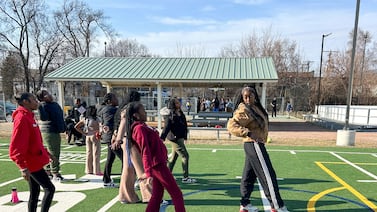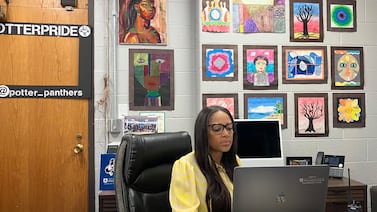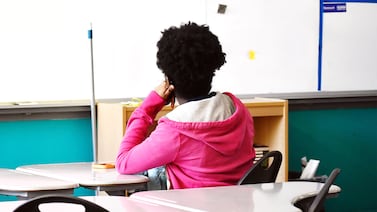New York City is tweaking the formula it uses to calculate how many students should get swabbed for each school’s weekly coronavirus testing program, school officials announced Monday.
In another change, officials announced that starting Wednesday only students who test positive or fail the city’s health screener will be eligible for remote instruction, reversing the policy from just two weeks ago that gave schools discretion to provide online work for students who stayed home for a variety of reasons.
A press release noted the move to limit remote learning was thanks to “improving conditions of the pandemic and increased levels of testing.” A record high of more than 14,000 COVID cases among students and staff was reported on Jan. 10, officials said. On Monday, three weeks later, the number dropped to 810, though New York City is still currently considered to have high transmission levels.
The COVID testing tweak aims to boost the number of PCRs for children on campuses with high vaccination rates. Despite that change, public health experts continue to raise concerns about whether the school-based testing protocols are an effective strategy for either interrupting transmission or giving city officials a sense of whether other measures such as mask wearing or ventilation are working.
Getting more kids tested
The city’s testing formula is complicated. Schools currently test the equivalent of 20% of their unvaccinated population who consented to testing, meaning schools with higher rates of vaccinated children have fewer students getting swabbed each week. For example, a school with 100 students and a 70% vaccination rate would test just six students. Those six students, however, are supposed to be a mix of vaccinated and unvaccinated students.
Starting on Feb. 7, that formula will stay in place for many schools. But others can test 10% of their overall student population — up to 250 — if that would result in more students being tested. So, for that same school with 100 students and a 70% vaccination rate, 10 students would be tested each week rather than six.
The testing program will still allow up to 10% of interested staff at a given school to be tested, though in practice some staff have reported challenges getting swabbed. (Pre-K and kindergarten students continue to be excluded from the school-based testing program.)
The change is designed to increase the number of students who are tested on campuses with high vaccination rates, which in some cases have seen tiny portions of their school community tested. But education department officials did not respond to questions about how many more students will be tested each week due to the policy change nor have they released vaccination or testing consent rates by school. The vast majority of students have not consented to testing, according to the most recent data, severely limiting the pool of students who are eligible in the first place.
Education officials have said they are considering automatically opting students into the testing program with an option to opt out, but have not done so.
More testing might not interrupt transmission
Officials have previously said their testing protocol is consistent with federal and state guidance, but did not offer an explanation of what goals the program is designed to accomplish.
Public health experts said the program has two possible objectives. One is to interrupt transmission by identifying students or staff who are infectious and removing them from school. The other is to monitor whether other measures like ventilation and masking are working and detect large-scale outbreaks in school communities.
Multiple experts said the city’s testing policy, even with the latest tweaks, was unlikely to have a big effect on interrupting transmission since the number of people being tested was too modest as was the frequency of testing. The increased speed of the omicron variant also means that if the test results take a few days to process, quarantines may be issued too late to have a large effect.
“As long as the random testing is done through PCR, it’s not going to accomplish a lot” in terms of preventing transmission, said Susan Hassig, an epidemiologist at Tulane University, especially because the results can take days to be reported.
Hassig said she would instead recommend deploying rapid tests for a given percentage of each school’s population, rather than PCR tests based on the share of unvaccinated students. PCR tests, she noted, may come back positive even if a person is not contagious, which appears to be less likely with rapid tests.
Experts offered differing views of whether the testing program could still be helpful to monitor whether other mitigation measures such as ventilation upgrades and mask-wearing were having the desired effect.
Anna Bershteyn, an assistant professor of population health at the NYU Grossman School of Medicine, said the school-based COVID testing program still offers some value and the latest tweaks could provide a broader sample of students to be tested at some schools.
“Even as vaccination numbers rise, it’s important to continue surveillance testing to make sure schools are not sites of transmission, and if they are, to devote more resources to strengthen layers of protection as needed,” she wrote in an email. “Testing can help to prioritize where the investments are needed most.”
City officials have said they will investigate schools when there are at least 10 positive cases in one classroom and determine whether to prioritize investments in ventilation at those campuses. Despite the post-winter break surge in cases, no investigations have been logged, according to public data.
Other experts said the city should consider ditching the in-school testing program entirely, especially as the city has rolled out a “test-to-stay” program that distributes at-home COVID tests to students and staff exposed to COVID in the classroom, allowing them to remain in school as long as they test negative.
Such a move, however, would likely frustrate the city’s teachers union and many educators who have called for increased PCR testing.
“The city has not made it clear what the goal of the policy is,” said Ben Linas, an epidemiologist at Boston University. “I think that the city should stop its random testing program and reinvest those resources into testing to stay and other mitigation measures.”
Pre-K added to at-home rapid kit distribution
Also on Monday, city officials said they are planning to expand the distribution of rapid tests before midwinter recess, which runs Feb. 21-25.
Gov. Kathy Hochul previously announced that the state would provide enough at-home tests for every K-12 student in the state. City officials said they would make the test kits available to preschool students as well.
Families will be encouraged, but not required, to use the tests before the break ends.
“Because of our extensive health and safety measures, COVID-19 cases in our schools have decreased 95%, and the in-school positivity rate remains significantly lower than the city-wide rate,” Nathaniel Styer, an education department spokesperson said in a statement. “Expanding in-school testing and at-home rapid tests will ensure every student is ready to safely attend instruction in-person after Midwinter Break.”






